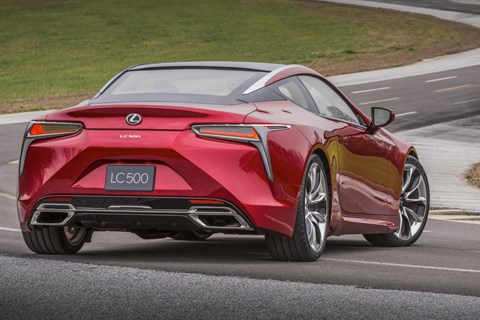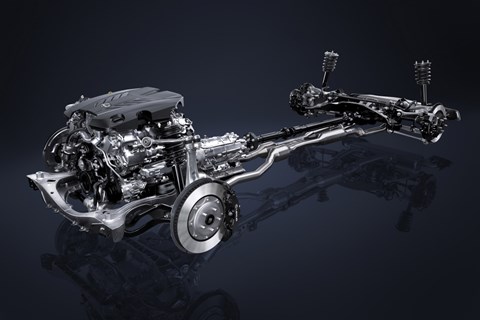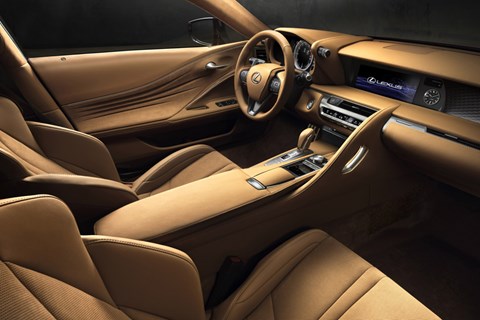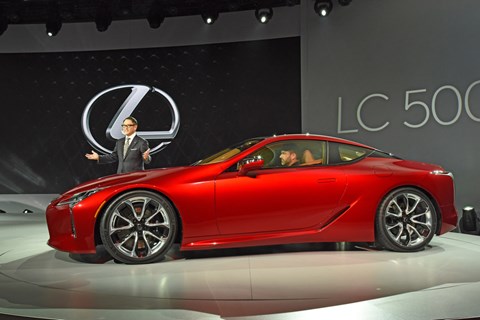► Lexus reveals LC 500 coupe at Detroit show
► Features 467bhp naturally aspirated V8
► Production ready, due to go on sale next year
You’re not going mad. Yes, it has four seats. Yes, it has the same naturally aspirated 5.0-litre V8. Yes, it’s rear-wheel drive and about the same size. But, no, really, this isn’t the Lexus RC F all over again.
This is, in fact, the new Lexus LC 500. It’s effectively a production version of the dramatic Lexus LF-LC concept that we saw at the Detroit motor show in 2012. It’s about the same size as a BMW M4, and not much different in size from Lexus’s RC F coupe.
Lexus says that the new LC 500 is more of a grand tourer, a high-performance luxury coupe, than it is a sports car – which is the RC F’s intended domain. Consider it an alternative to the likes of a BMW M6, Mercedes-AMG GT or even a Porsche 911.
The LC 500 will act as a flagship for the brand and, more prominently, will form part of the company’s ongoing drive to shed the dull, uninteresting nature that many perceive it to have.
Looks pretty sharp – and is that a carbonfibre roof?
Distinctive, isn’t it. It features the trademark Lexus ‘spindle’ grille, L-shaped daytime running lights, triple-LED headlamps, a rear diffuser and functional air vents to boost stability and cooling.
The carbonfibre roof is optional, however. As standard, the LC 500 comes with a glass roof, along with 20in alloy wheels. You can opt for 21in forged wheels, however, as well as an active rear spoiler.

Has it got the muscle to match its high-performance looks?
Under the LC 500’s bonnet you’ll find a naturally aspirated 5.0-litre V8 that punches out 467bhp at 7100rpm, and 389lb ft at 4800rpm, which is sent to the rear wheels via a ten-speed automatic gearbox.
Lexus quotes a 0-60mph time of ‘less than 4.5sec’, which means it’ll lag behind the likes of a BMW M4 and Mercedes-AMG GT by a few tenths of a second, but the V8 Lexus’s turbo-free nature will likely be judged an acceptable tradeoff by buyers.
You can expect that engine, judging by the company’s previous V8s, to take anything you can throw at it – thanks to features including forged connecting rods and titanium valves. An active exhaust system should grant suitable audible fireworks while delivering a relaxed, quiet cruising note for long-distance drives.
Some might be concerned by the fitment of a conventional torque-converter automatic, despite it having ten ratios – which admittedly it probably needs to make up for its relative lack of torque alongside single- and twin-turbocharged rivals.
Lexus, however, says that the 10-speed automatic can rival the shift times of dual-clutch gearboxes and new control software, which monitors braking, cornering force and acceleration, helps it do a better job of picking the right one of its many ratios.

Underpinning the LC 500 is Lexus’s new rear-drive luxury platform, dubbed GA-L. A ‘luxury’ platform might not sound a great starting point for a sports coupe, but the company’s fettled and finessed the design to get the best out of it – including mounting the V8 low down and as far back in the engine bay as possible.
There’s a host of ‘mass management’ going on, including carbonfibre door structures, aluminium door skins and a composite boot floor. Lexus claims a weight distribution of 52/48, which is close to the ideal. There’s a lot of high-strength steel throughout the car’s structure, too, as well as significant bracing in twist-prone areas, which should help bolster its rigidity and improve its handling and responses.
Chief engineer Koji Sato said: ‘We spent more than triple the usual amount of R&D time to pursue linear steering and to find the sweet spot for road contact feel. We also focused our efforts on suspension rigidity and enhancing geometry.’
There shouldn’t be any problems bringing the Lexus to a halt, either, with substantial disc brakes all round, clamped by six-piston calipers at the front and four-piston calipers at the rear.

What about the interior?
Lexus has reputedly focused on the key elements of the interior that are key for a high-performance coupe, like ensuring the seats offer adequate support and that the wheel is of the right size. It’s even tried to ensure that the driver’s hip point is as close to the LC 500’s centre of gravity, improving communication between car and driver.
‘At an early stage, the designers collaborated with the engineers to understand their image for the LC 500’s driving dynamics, and they incorporated this into the design,’ said Tadao Mori, the chief designer of the LC 500. ‘For example, we gave serious consideration to where the driver’s eyes would focus, and designed the surface shape in that area to help support a driver’s mindset.’
Expect the cabin’s detailing and quality to be on point, too. Leather and Alcantara trim will be available, and you know everything will be assembled to a high standard. There are no plastic shift paddles here, either; Lexus has fitted suitably tactile magnesium alloy paddle shifters. Just what you’d expect in a high-end coupe.
The launch of the LC 500 will also mark the debut of the Lexus’s new multimedia system, which promises to be faster and better looking. A Pioneer sound system is standard and, predictably, a high-end Mark Levinson audio system will be available. You’ll also get active cruise control, lane keeping assistance and a battery of other safety systems.

When’s it going to arrive and how much will it cost?
The Lexus LC 500 is set to arrive in 2017, although an exact date is yet to be confirmed. There’s also no line on UK pricing, with only a US-market figure of $100,000 being quoted as a starting point for the model range.
Consequently, it’s best to assume that, if and when it arrives, the new Lexus LC 500 will cost in the region of £90,000 without options, putting it on a par with the likes of the £97k Mercedes-AMG GT.
Read more of CAR’s Detroit motor show coverage here.